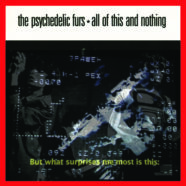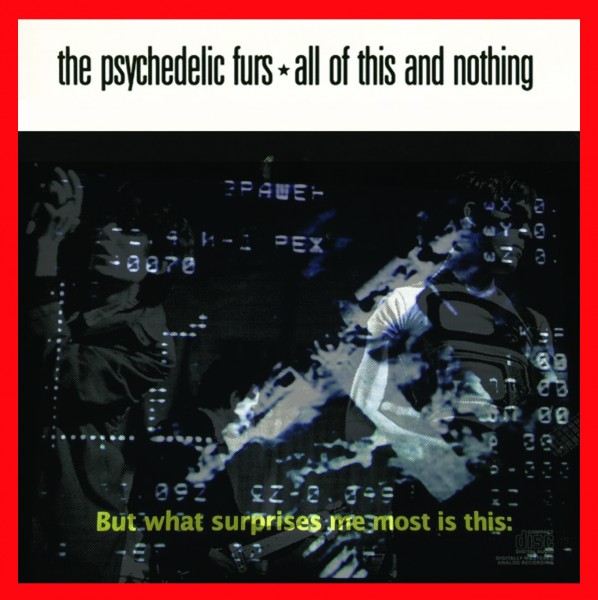Everything and Nothing
“All of This and Nothing. I mean, I think it just works so well for this show, right?” He’s smiling because he’s just finished telling us that the title of the Psychedelic Furs song from their eponymous 1981 album Talk Talk Talk came to him a month ago, like a bolt from the blue, while driving to a curatorial meeting in which the title of the Hammer Museum’s conceptually ambitious exhibition, All of This and Nothing was then, as yet to be determined. And, as he tells it, being a staunch fan of The Furs, not to mention somewhat of a conceptually, and pop-culturally savvy dude, he saw a perfect opportunity to contextualize the work of roughly a dozen disparate contemporary artists under this single unifying umbrella: this – according to him – fitting, poetically concise moniker. The “he” in question was Douglas Fogle, acting as museum tour guide to a group of art students, myself included, who had come to the Hammer seeking enlightenment. I gather he is a rather important figure, all the signs are there: simple yet elegant shoes, designer jeans, immaculately sculpted coif, and the fact that he can really, you know, “talk” about Art. You know the way I mean, the way we all secretly wish, in our darkest of hearts, that we could talk about Art, even though, if we’re honest, we usually find it to be rather pretentious, even a wee bit condescending when we’re forced to endure listening to it. But even were it not for these tell-tale signs, I was also fully aware that our guide was not your average docent, in fact it turned out he’s the chief curator for the Hammer Museum, a position he only recently (2 years? recent enough in the art world scheme of things anyway) attained, and the warm afterglow of this culturally significant achievement still permeates his – dare-I-say-it – boyishly toothy grin. Presently I looked up from those unnaturally white teeth to realize he’s looking at me. What’s worse, he’s still talking.
As I listened, or did my best impression of someone who is deeply involved with every syllable escaping our overly qualified speaker’s lips, I couldn’t help but fixate on the fact that this moment seemed somehow indicative of a bigger contemporary moment currently happening not only in the art world, but also in the world at large. When did engagement become so passive? When did we let all of the information, all of the analysis, empirical dogma – the authoritative words, trump the pure, mystical profundity of unencumbered experience? In a world where everything is so immediately accessible, and readily available at the touch of a highly sophisticated and meticulously engineered screen that fits in the palm of your hand, it can become dangerously easy to forget, or take for granted, the human cost, the human terms that made, and still make, such seemingly miraculous things possible. Magic is part of our everyday lives, yet we cannot see it.
In some ways, I think we’ve all given in, to one degree or another, to the contextualization provided for us by everything and for everything by an image and media-saturated culture, making it harder and harder to just see things for what they are. How do they affect us, when the words, or numbers, or binary codes aren’t there to frame them for us, guiding us by the hand like an over-qualified docent, categorizing, reducing, and commodifying them for our pleasure? (As I type this, I realize I’ve used the spell-check function on my MacBook Pro no less than five times for this paragraph alone, and the irony is using a nine-pound hammer to ensure that this fact is not lost on me.) Is it possible to escape? Is it even possible in modern life to just experience in a completely pure sense? To see a film without knowing who of the who’s-who-set is starring in it, what the general populace’s consensus is in regards to its value as it pertains to a night out, while simultaneously seeing multiple behind-the-scenes, making-of featurettes, not to mention every significant scene the movie has to offer? To hear a song without knowing every detail about its creation: where and who and why it was made, the way it relates to every other song of a particular subset, and what other songs you would probably like if this one is so agreeable to you? Our tour through that particular contemporary group museum exhibition reminded me that such is the world I live in, and it’s making it harder for me to see a way out.
We moved from one hardly-there hyper-conceptual installation piece to the next, only to encounter more indecipherable, impenetrable photographs, and then on to paintings that beg – or is it dare? – you to reject and dispute them or their right to exist, all the while being regaled with anecdotal, historical, and contextual information which, rather than enriching the artwork before us, served to flatten it, robbing it of the “magic” this particular exhibition seemed hell-bent at the outset to establish. The object-hood of the mundane and everyday these artists had so valiantly pitted against the all-consuming information age struggled in vain with the more metaphysical, transcendental, lyrical notions of presence, immediacy, and autonomy. In the end, we still need so many words to make them “real.”
But art and culture at their best have always been glorious funhouse mirrors in which we humans can see our reflection not for what it is per se, but for what it could be at its most distorted extremes, and by that standard it’s impossible not to appreciate these artists’ works for what they tell us about the 21st century human condition. We don’t want to be given too much, perhaps we’re only too acutely aware that we already have too much, and we certainly don’t want to work too hard for or think too hard about what we already have, and what we should do with it. So where does that leave us? We have so much of it. All of this. Nothing.
I’m back to thinking about the Psychedelic Furs, and it occurs to me only later that the album Talk Talk Talk was released on my third birthday, a fact which I can’t exactly imbue with cosmic significance, but seems strangely appropriate somehow, given the trajectory of my life and popular culture up to this very moment in front of this particular computer screen typing, typing, typing my way of talking, talking, talking, bemoaning all the talk, talk… you get the picture. It does make it easier somehow, to just let the talking take over. Letting it compartmentalize, categorize, define, and systematize everything around us certainly helps eradicate the fear we all feel when faced with the void of finite existence. Suddenly there is a logical, rational, digestible progression leading us down the rabbit hole. And if you should start to get frightened just whip out your phone and let the world tell you why it should matter, even if it’s lying. The Furs put it best, in the song that inspired our hero, chief curator Douglas Fogle, to put on this artsy show, and more importantly give it a snazzy title. I’ll let the ending lyrics of that song take this endless blather to its final resting place:
Hey I never meant that stuff
I want to turn you on
The sound of people getting drunk
A ceiling and a sky
A bank that’s full of promises
A telephone that lies
A visit from your doctor
He crawls in through the door
A mirror you can look in
So that you know where you are
You didn’t leave me anything
That I can understand
Now I’m left with all of this
A room full of your trash
Not bad for 1981. Maybe Doug was on to something.








Right on!